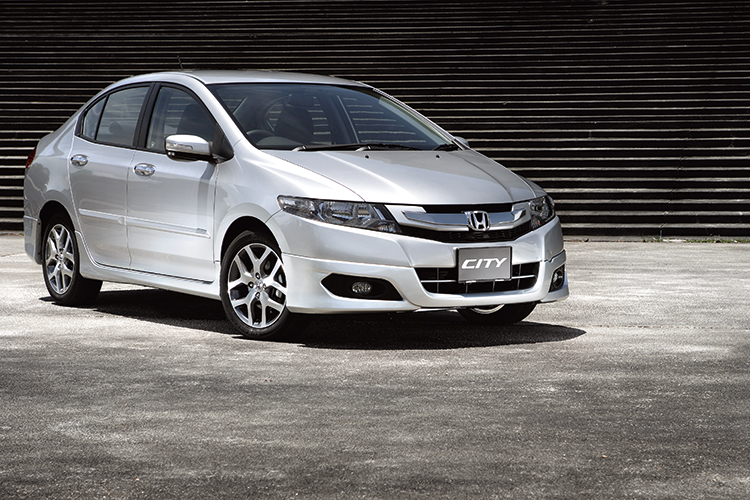
Ralf Schumacher did it. Jacques Villeneuve did it, too. Nelson Piquet Jr has obviously done it.
There’s nothing wrong with “riding” on the coat-tails of your successful father (or in the case of Ralf, your big brother).
Raw talent aside, the three men must also thank their last names for giving them their chance in Formula One.
Maybe the Honda City should have done the same and called itself the “Jazz Sedan” earlier.
Then the second-generation model wouldn’t have had so much trouble finding its place in the world.

People will go to the showroom looking at the wonderful Jazz hatchback and maybe decide that they prefer the “sedan version”.
Admittedly, that is a stretch. Although the previous Honda City really was a Jazz-with-a-backside, the rump in question was massively ungainly to look at.
It seems that Honda has learnt its lesson. The new car is still called the Honda City – no point wasting the brand equity the car enjoys in, well, some places – but it is properly differentiated from the Jazz.
And the Honda City takes on grander aspirations and aligns itself with the Honda Civic, Honda’s most successful sedan in the line-up today.
The futuristic monospace styling works to give the Honda City an avant-garde look. The test car’s luscious metallic silver paint definitely helps here.

The interior carries some nice-looking curves, even if some of the materials used here feel less than premium.
And there’s surprisingly little headroom.
The optional bodykit goes some way to add some visual drama and a big dose of sportiness to the sedan body style.
Despite the highly differentiated styling, the Honda City borrows heavily from the Jazz’s underpinnings, which is found to be more matured and sophisticated than its predecessor.

F1-style paddle shifters add to the Honda City’s sporty feel.
The front strut/rear torsion beam suspension set-up is no different from the older car, but the detail setting has made all the difference.
The suspension is firmer than before but also manages to give more pliancy. The result is a car that feels more confident on the road and a cabin that seems as settled as a larger car’s.
The 120bhp i-Vtec engine is also suitably lively, with the 5-speed automatic (with sporty sequential shift) offering very direct control.

Under normal circumstances, the 1.5-litre engine doesn’t immediately feel like it has a full 20bhp more than the 1.3-litre Jazz (the City is only available with the 1.5).
But the bigger engine proves itself in that it seems to take a little bit less effort to nudge the expressway speed limits or regain velocity.
As with the 1.3, the SOHC unit doesn’t seem to thrive on the higher revs as the Honda City’s siblings that use the more illustrious twin-cam i-Vtec engines.

Premium grade model comes with this good-looking integrated stereo.
Following closely in the footsteps of the popular Honda Civic, the City also features premium pricing, a trait we would rather do without.
The tested premium LX model carries lots of equipment, ranging from an integrated head unit with USB connectivity and an excellent split-folding rear bench, which goes some way to justifying the extra $3000 over the standard $63,800 City.
Why people will pick this over larger sedans is not immediately clear – someone looking for a miniaturised Civic, perhaps?

Honda City LX 1.5 (A)
DRIVETRAIN
Type Inline-4, 16-valves
Capacity 1497cc
Bore x stroke 73mm x 89.4mm
Compression ratio 10.4:1
Max power 120hp at 6600rpm
Max torque 145Nm at 4800rpm
Power to weight 108.1hp per tonne
Gearbox 5-speed automatic with manual select
Driven wheels Front
PERFORMANCE
0-100km/h 12.2 seconds
Top speed 185km/h
Consumption 15.2km/L (combined)
SUSPENSION
Front MacPherson struts, coil springs
Rear Torsion beam, adaptive dampers
BRAKES
Front / Rear Ventilated discs / Discs
TYRES
Type Bridgestone Turanza ER370
Size 185/65 R20
SAFETY
Airbags 2
Traction aids ABS
MEASUREMENTS
Length 4395mm
Width 1715mm
Height 1470mm
Wheelbase 2550mm
Kerb weight 1110kg
Turning circle 10.4m
BUYING IT
Price incl. COE $66,300
Warranty 3 years/100,000km
+ Monospace styling, lively engine, better looking than previous incarnation
– Limited headroom, some plastics should be better, premium pricing












